Effects of Moss Overlay on Soil Patch Infiltration and Runoff in Karst Rocky Desertification Slope Land
Abstract
1. Introduction
2. Experimental Materials and Methods
2.1. Experimental Materials and Design
2.2. Experimental Method
2.3. Data Analysis
3. Results
3.1. Effect of Moss Cover on Spatial Distribution of Runoff
3.2. Effect of Moss Cover on Percolation-Runoff Process
3.3. Correlation Analysis of Moss Cover between Exposed Bedrock on Percolation-Runoff
4. Discuss
4.1. The Effect of Moss Overlay on the Spatial Distribution of Slope Runoff between Exposed Bedrocks
4.2. The Effect of Moss Coverage on the Runoff Process between Exposed Bedrock Slopes
5. Conclusions
Author Contributions
Funding
Data Availability Statement
Conflicts of Interest
References
- Wang, S.-J.; Liu, Q.-M.; Zhang, D.-F. Karst Rocky Desertification in Southwestern China: Geomorphology, Landuse, Impact and Rehabilitation. Land Degrad. 2004, 7, 115–121. [Google Scholar] [CrossRef]
- Li, Y.; Shao, J.; Yang, H.; Bai, X. The Relations between Land Use and Karst Rocky Desertification in a Typical Karst Area, China. Environ. Geol. 2009, 57, 621–627. [Google Scholar] [CrossRef]
- Zhou, L. The Challenge of Soil Loss Control and Vegetation Restoration in the Karst Area of Southwestern China. Int. Soil Water Conserv. Res. 2020, 9, 26–34. [Google Scholar] [CrossRef]
- Jiang, Z.; Lian, Y.; Qin, X. Rocky Desertification in Southwest China: Impacts, Causes, and Restoration. Earth Sci. Rev. 2014, 12, 1–12. [Google Scholar] [CrossRef]
- Dai, Q.; Peng, X.; Wang, P.; Li, C.; Shao, H. Surface Erosion and Underground Leakage of Yellow Soil on Slopes in Karst Regions of Southwest China. Land Degrad. Dev. 2018, 29, 2438–2448. [Google Scholar] [CrossRef]
- Peng, X. Role of Underground Fissure Flow in Near-Surface Rainfall-Runoff Process on a Rock Mantled Slope in the Karst Rocky Desertification Area. Eng. Geol. 2018, 243, 10–17. [Google Scholar] [CrossRef]
- Wang, J.; Zou, B.; Liu, Y.; Tang, Y.; Zhang, X.; Yang, P. Erosion-Creep-Collapse Mechanism of Underground Soil Loss for the Karst Rocky Desertification in Chenqi Village, Puding County, Guizhou, China. Environ. Earth Sci. 2014, 72, 2751–2764. [Google Scholar] [CrossRef]
- Zhang, Z.; Huang, X.; Zhou, Y. Factors Influencing the Evolution of Human-driven Rocky Desertification in Karst Areas. Land Degrad. Dev. 2021, 32, 817–829. [Google Scholar] [CrossRef]
- Chengfang, L.; Zhongcheng, W.; Zhenwei, L.; Xianli, X. Soil erosion impacts on nutrient deposition in a typical karst watershed. Agric. Ecosyst. Environ. 2021, 322, 107649. [Google Scholar] [CrossRef]
- Tani, M. Runoff Generation Processes Estimated from Hydrological Observations on a Steep Forested Hillslope with a Thin Soil Layer. J. Hydrol. 1997, 200, 84–109. [Google Scholar] [CrossRef]
- Gao, J.; Wang, H. Temporal Analysis on Quantitative Attribution of Karst Soil Erosion: A Case Study of a Peak-Cluster Depression Basin in Southwest China. CATENA 2019, 172, 369–377. [Google Scholar] [CrossRef]
- Gan, F.; He, B.; Qin, Z.; Li, W. Role of Rock Dip Angle in Runoff and Soil Erosion Processes on Dip/Anti-Dip Slopes in a Karst Trough Valley. J. Hydrol. 2020, 588, 125093. [Google Scholar] [CrossRef]
- Yang, T.; Chen, Q.; Yang, M.; Wang, G.; Zheng, C.; Zhou, J.; Jia, M.; Peng, X. Soil Microbial Community under Bryophytes in Different Substrates and Its Potential to Degraded Karst Ecosystem Restoration. Int. Biodeterior. Biodegrad. 2022, 175, 105493. [Google Scholar] [CrossRef]
- Zhang, X.; Zhao, Y.; Wang, S. Responses of Antioxidant Defense System of Epilithic Mosses to Drought Stress in Karst Rock Desertified Areas. Acta Geochim. 2017, 36, 205–212. [Google Scholar] [CrossRef]
- Biological Soil Crusts: Structure, Function, and Management; Belnap, J., Lange, O.L., Eds.; Ecological Studies; Springer: New York, NY, USA, 2001; ISBN 9783540410751. [Google Scholar]
- Ni, J.; Luo, D.H.; Xia, J.; Zhang, Z.H.; Hu, G. Vegetation in Karst Terrain of Southwestern China Allocates More Biomass to Roots. Solid Earth 2015, 6, 799–810. [Google Scholar] [CrossRef]
- Wu, Z.; Behzad, H.M.; He, Q.; Wu, C.; Bai, Y.; Jiang, Y. Seasonal Transpiration Dynamics of Evergreen Ligustrum Lucidum Linked with Water Source and Water-Use Strategy in a Limestone Karst Area, Southwest China. J. Hydrol. 2021, 12, 126199. [Google Scholar] [CrossRef]
- Moor, H.; Norberg, J. Towards a Trait-based Ecology of Wetland Vegetation. J. Ecol. 2017, 13, 1623–1635. [Google Scholar] [CrossRef]
- Li, S.; Xiao, B. Cyanobacteria and Moss Biocrusts Increase Evaporation by Regulating Surface Soil Moisture and Temperature on the Northern Loess Plateau, China. CATENA 2022, 212, 106068. [Google Scholar] [CrossRef]
- Jia, R.; Li, X.; Liu, L.; Pan, Y.; Gao, Y.; Wei, Y. Effects of Sand Burial on Dew Deposition on Moss Soil Crust in a Revegetated Area of the Tennger Desert, Northern China. J. Hydrol. 2014, 519, 2341–2349. [Google Scholar] [CrossRef]
- Dai, Q.; Peng, X.; Yang, Z.; Zhao, L. Runoff and Erosion Processes on Bare Slopes in the Karst Rocky Desertification Area. CATENA 2017, 152, 218–226. [Google Scholar] [CrossRef]
- Song, L.; Zhang, Y.J.; Chen, X.; Li, S.; Lu, H.-Z.; Wu, C.-S.; Tan, Z.-H.; Liu, W.-Y.; Shi, X.-M. Water Relations and Gas Exchange of Fan Bryophytes and Their Adaptations to Microhabitats in an Asian Subtropical Montane Cloud Forest. J. Plant Res. 2015, 128, 573–584. [Google Scholar] [CrossRef]
- Fischer, T.; Veste, M.; Schaaf, W. Initial Pedogenesis in a Topsoil Crust 3 Years after Construction of an Artificial Catchment in Brandenburg, NE Germany. Biogeochemistry 2010, 101, 165–176. [Google Scholar] [CrossRef]
- Belnap, J.; Wilcox, B.P.; Scoyoc, M.W.V.; Phillips, S.L. Successional Stage of Biological Soil Crusts: An Accurate Indicator of Ecohydrological Condition. Ecohydrology 2013, 6, 474–482. [Google Scholar] [CrossRef]
- Liu, D.; She, D. Combined Effects of Moss Crusts and Pine Needles on Evaporation of Carbonate-Derived Laterite from Karst Mountainous Lands. J. Hydrol. 2020, 586, 124859. [Google Scholar] [CrossRef]
- Zhao, L.; Liu, Y.; Wang, Z.; Yuan, S.; Qi, J.; Zhang, W.; Wang, Y.; Li, X. Bacteria and fungi differentially contribute to carbon and nitrogen cycles during biological soil crust succession in arid ecosystems. Plant Soil 2020, 447, 379–392. [Google Scholar] [CrossRef]
- Zhang, Y. Soil Nutrients, Enzyme Activities, and Microbial Communities Differ among Biocrust Types and Soil Layers in a Degraded Karst Ecosystem. CATENA 2022, 212, 106057. [Google Scholar] [CrossRef]
- Cheng, C.; Li, Y.; Long, M.; Gao, M.; Zhang, Y.; Lin, J.; Li, X. Moss Biocrusts Buffer the Negative Effects of Karst Rocky Desertification on Soil Properties and Soil Microbial Richness. Plant Soil 2022, 475, 153–168. [Google Scholar] [CrossRef]
- Ren, H.; Wang, F.; Ye, W.; Zhang, Q.; Han, T.; Huang, Y.; Chu, G.; Hui, D.; Guo, Q. Bryophyte Diversity Is Related to Vascular Plant Diversity and Microhabitat under Disturbance in Karst Caves. Ecol. Indic. 2021, 120, 106947. [Google Scholar] [CrossRef]
- Chamizo, S.; Cantón, Y.; Miralles, I.; Domingo, F. Biological Soil Crust Development Affects Physicochemical Characteristics of Soil Surface in Semiarid Ecosystems. Soil Biol. Biochem. 2012, 49, 96–105. [Google Scholar] [CrossRef]
- Peng, X.; Dai, Q.; Ding, G.; Li, C. Role of underground leakage in soil, water and nutrient loss from a rock-mantled slope in the karst rocky desertification area. J. Hydrol. 2019, 578, 124086. [Google Scholar] [CrossRef]
- Dai, Q.; Peng, X.; Zhao, L.; Shao, H.; Yang, Z. Effects of Underground Pore Fissures on Soil Erosion and Sediment Yield on Karst Slopes. Land Degrad. 2017, 28, 1922–1932. [Google Scholar] [CrossRef]
- Yan, Y.; Dai, Q.; Yuan, Y.; Peng, X.; Zhao, L.; Yang, J. Effects of Rainfall Intensity on Runoff and Sediment Yields on Bare Slopes in a Karst Area, SW China. Geoderma 2018, 330, 30–40. [Google Scholar] [CrossRef]
- Wang, Y. Effect of Antecedent Soil Water Content on Infiltration-Runoff during Simulated Rainfall; Graduate Institute of Chinese Academy of Sciences (Soil and Water Conservation and Ecological Environment Research Center of Ministry of Education): Yangling, China, 2016. (In Chinese) [Google Scholar]
- Römkens, M.J.M.; Helming, K.; Prasad, S.N. Soil Erosion under Different Rainfall Intensities, Surface Roughness, and Soil Water Regimes. CATENA 2002, 46, 103–123. [Google Scholar] [CrossRef]
- Zhang, X.; Bai, X.; He, X. Soil Creeping in the Weathering Crust of Carbonate Rocks and Underground Soil Losses in the Karst Mountain Areas of Southwest China. Carbonates Evaporites 2011, 26, 149–153. [Google Scholar] [CrossRef]
- Yang, J. Saturation effects on horizontal and vertical motions in a layered soil–bedrock system due to inclined SV waves. Soil Dyn. Earthq. Eng. 2001, 21, 527–536. [Google Scholar] [CrossRef]
- Wright, S.N.; Novakowski, K.S. Numerical Analysis of Midwinter Infiltration along the Soil-Rock Interface: A Pathway for Enhanced Bedrock Recharge. Adv. Water Resour. 2022, 166, 104261. [Google Scholar] [CrossRef]
- Sohrt, J.; Ries, F.; Sauter, M.; Lange, J. Significance of Preferential Flow at the Rock Soil Interface in a Semi-Arid Karst Environment. CATENA 2014, 123, 1–10. [Google Scholar] [CrossRef]
- Raizada, A.; Juyal, G.P. Tree Species Diversity, Species Regeneration and Biological Productivity of Seeded Acacia Catechu Willd. In Rehabilitated Limestone Mines in the North West Indian Himalayas. Land Degrad. 2012, 23, 167–174. [Google Scholar] [CrossRef]
- Peng, X. Drivers of Soil Erosion and Subsurface Loss by Soil Leakage during Karst Rocky Desertification in SW China. Int. Soil Water Conserv. Res. 2022, 10, 217–227. [Google Scholar] [CrossRef]
- Fang, Q.; Zhao, L.; Hou, R.; Fan, C.; Zhang, J. Rainwater Transformation to Runoff and Soil Loss at the Surface and Belowground on Soil-Mantled Karst Slopes under Rainfall Simulation Experiments. CATENA 2022, 215, 106316. [Google Scholar] [CrossRef]
- Peng, J.; Wang, F.; Cheng, Y.; Lu, Q. Characteristics and Mechanism of Sanyuan Ground Fissures in the Weihe Basin, China. Eng. Geol. 2018, 247, 48–57. [Google Scholar] [CrossRef]
- Fang, N.-F.; Shi, Z.-H.; Li, L.; Guo, Z.-L.; Liu, Q.-J.; Ai, L. The Effects of Rainfall Regimes and Land Use Changes on Runoff and Soil Loss in a Small Mountainous Watershed. CATENA 2012, 99, 1–8. [Google Scholar] [CrossRef]
- Mohamadi, M.A.; Kavian, A. Effects of Rainfall Patterns on Runoff and Soil Erosion in Field Plots. Int. Soil Water Conserv. Res. 2015, 3, 273–281. [Google Scholar] [CrossRef]
- Fang, H.; Sun, L.; Tang, Z. Effects of rainfall and slope on runoff, soil erosion and rill development: An experimental study using two loess soils. Hydrol. Process. 2015, 29, 2649–2658. [Google Scholar] [CrossRef]
- Han, D.; Deng, J.; Gu, C.; Mu, X.; Gao, P.; Gao, J. Effect of Shrub-Grass Vegetation Coverage and Slope Gradient on Runoff and Sediment Yield under Simulated Rainfall. Int. J. Sediment Res. 2021, 36, 29–37. [Google Scholar] [CrossRef]
- Puigdefábregas, J. The Role of Vegetation Patterns in Structuring Runoff and Sediment Fluxes in Drylands: Vegetation and Sediment FLuxes. Earth Surf. Process. Landf. 2005, 30, 133–147. [Google Scholar] [CrossRef]
- Saxena, D.K. Harinder Uses of Bryophytes. Reson 2004, 9, 56–65. [Google Scholar] [CrossRef]
- Oishi, Y. Evaluation of the Water-Storage Capacity of Bryophytes along an Altitudinal Gradient from Temperate Forests to the Alpine Zone. Forests 2018, 9, 433. [Google Scholar] [CrossRef]
- Ah-Peng, C.; Cardoso, A.W.; Flores, O.; West, A.; Wilding, N.; Strasberg, D.; Hedderson, T.A. The role of epiphytic bryophytes in interception, storage, and the regulated release of atmospheric moisture in a tropical montane cloud forest. J. Hydrol. 2017, 548, 665–673. [Google Scholar] [CrossRef]
- Ziadat, F.M.; Taimeh, A.Y. Effect of rainfall intensity, slope, land use and antecedent soil moisture on soil erosion in an arid environment. Land Degrad. Dev. 2013, 24, 582–590. [Google Scholar] [CrossRef]
- Zhang, X.; Yu, G.Q.; Li, Z.B.; Li, P. Experimental Study on Slope Runoff, Erosion and Sediment under Different Vegetation Types. Water Resour Manag. 2014, 28, 2415–2433. [Google Scholar] [CrossRef]
- Kim, J.K.; Onda, Y.; Kim, M.S.; Yang, D.Y. Plot-Scale Study of Surface Runoff on Well-Covered Forest Floors under Different Canopy Species. Quat. Int. 2014, 344, 75–85. [Google Scholar] [CrossRef]
- Guevara-Escobar, A.; Gonzalez-Sosa, E.; Ramos-Salinas, M.; Hernandez-Delgado, G.D. Experimental analysis of drainage and water storage of litter layers. Hydrol. Earth Syst. Sci. 2007, 11, 1703–1716. [Google Scholar] [CrossRef]
- Chamizo, S.; Cantón, Y.; Domingo, F.; Belnap, J. Evaporative losses from soils covered by physical and different types of biological soil crusts. Hydrol. Process. 2013, 27, 324–332. [Google Scholar] [CrossRef]
- Rodríguez-Caballero, E.; Cantón, Y.; Chamizo, S.; Afana, A.; Solé-Benet, A. Effects of biological soil crusts on surface roughness and implications for runoff and erosion. Geomorphology 2012, 145, 81–89. [Google Scholar] [CrossRef]
- Liu, F.; Zhang, G.; Sun, L.; Wang, H.; Sun, L. Effects of biological soil crusts on soil detachment process by overland flow in the Loess Plateau of China. Earth Surf. Process. Landf. 2016, 41, 875–883. [Google Scholar] [CrossRef]
- Chamizo, S.; Cantón, Y.; Lázaro, R.; Solé-Benet, A.; Domingo, F. Crust Composition and Disturbance Drive Infiltration Through Biological Soil Crusts in Semiarid Ecosystems. Ecosystems 2012, 15, 148–161. [Google Scholar] [CrossRef]
- Zhao, Y.; Xu, M. Runoff and soil loss from revegetated grasslands in the hilly Loess Plateau region, China: Influence of biocrust patches and plant canopies. J. Hydrol. Eng. 2013, 18, 387–393. [Google Scholar] [CrossRef]
- Tu, N.; Yan, Y.; Dai, Q.; Ren, Q.; Meng, W.; Zhu, L.; Cen, L. Soil-fixing and water-retaining effects of lithophytic mosses in typical habitats of karst rocky desertification areas. Ecology 2021, 41, 6203–6214. [Google Scholar] [CrossRef]
- Paradelo, R.; van Oort, F.; Barré, P.; Billiou, D.; Chenu, C. Soil Organic Matter Stabilization at the Pluri-Decadal Scale: Insight from Bare Fallow Soils with Contrasting Physicochemical Properties and Macrostructures. Geoderma 2016, 275, 48–54. [Google Scholar] [CrossRef]
- Sorochkina, K.; Velasco Ayuso, S.; Garcia-Pichel, F. Establishing Rates of Lateral Expansion of Cyanobacterial Biological Soil Crusts for Optimal Restoration. Plant Soil 2018, 429, 199–211. [Google Scholar] [CrossRef]
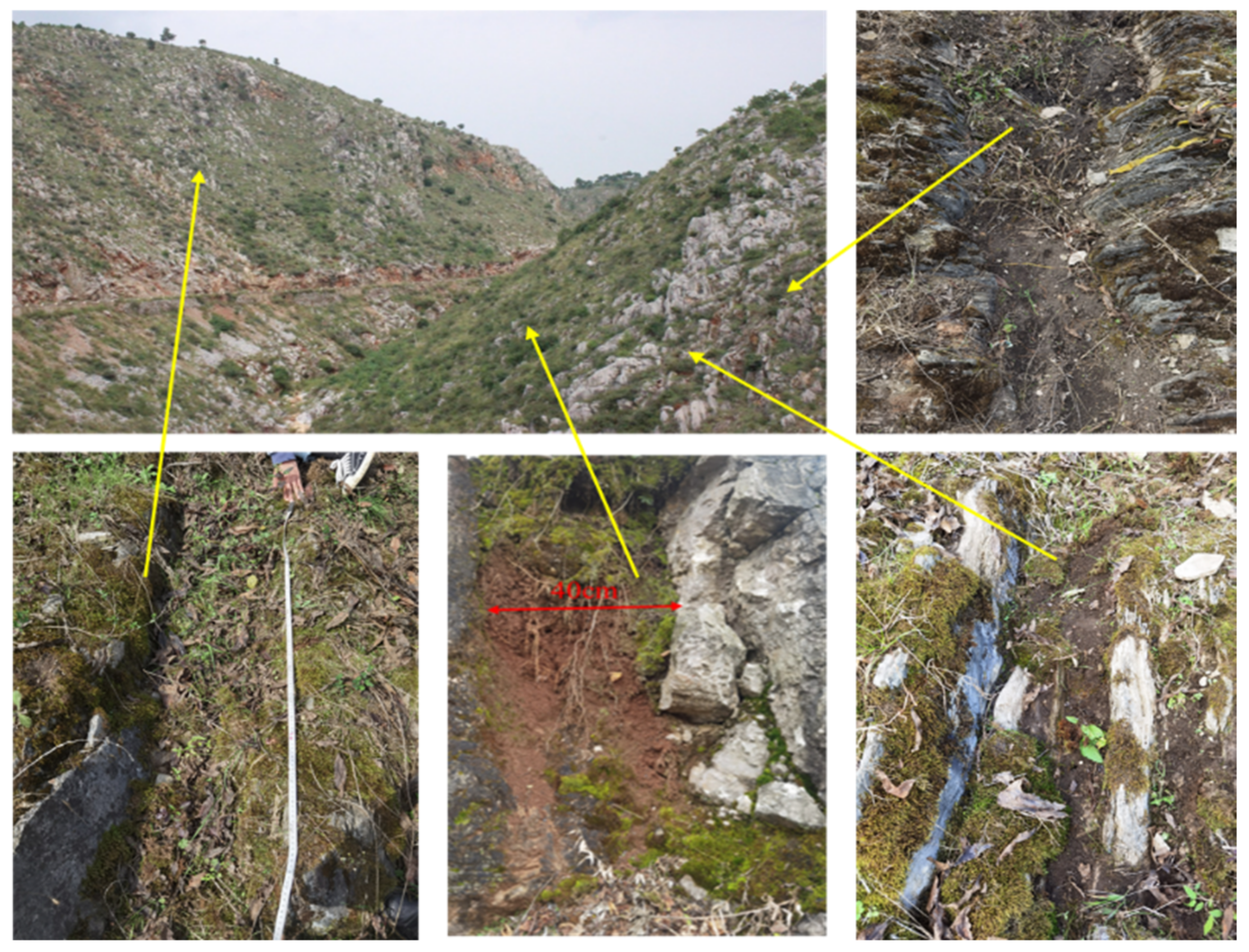
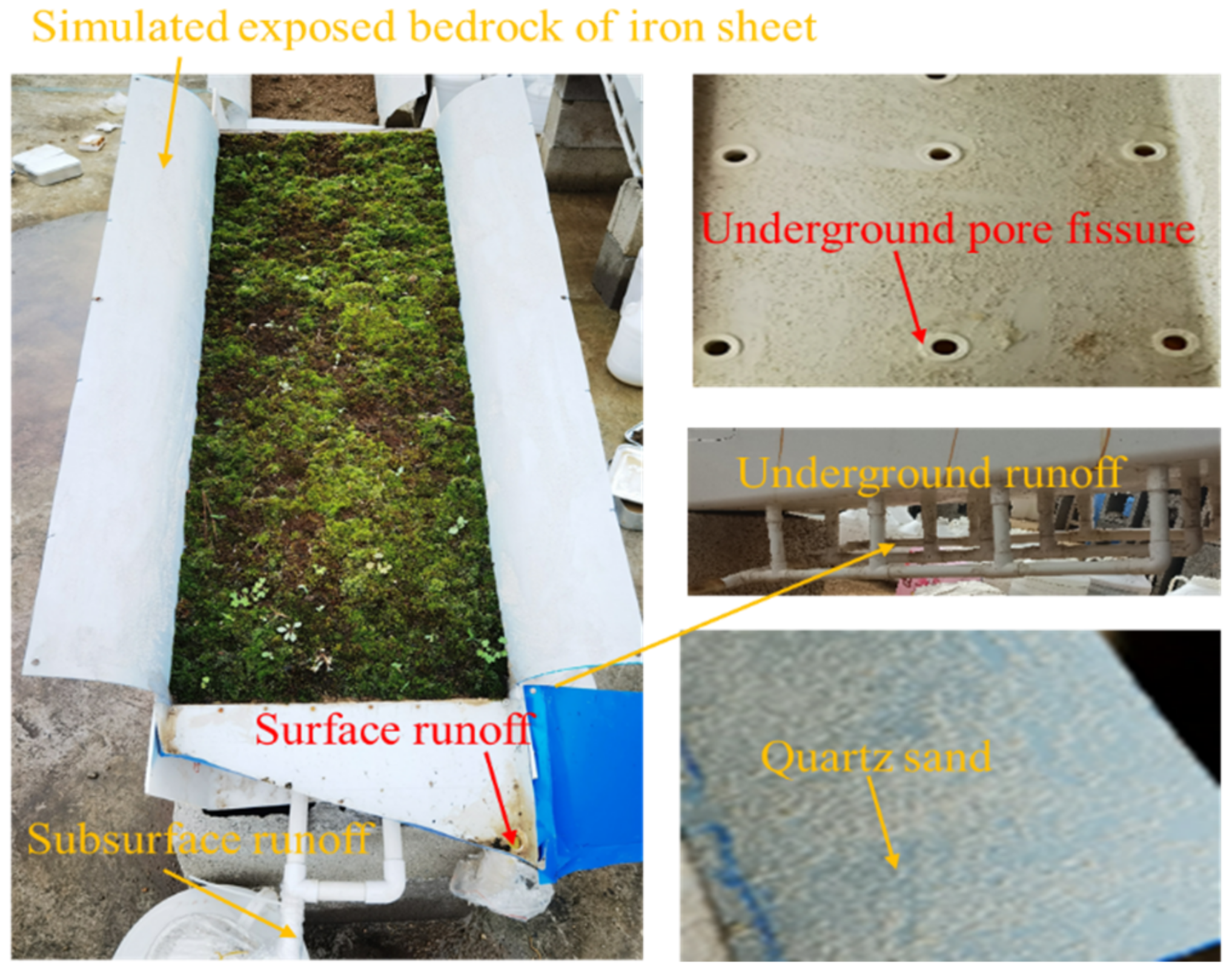
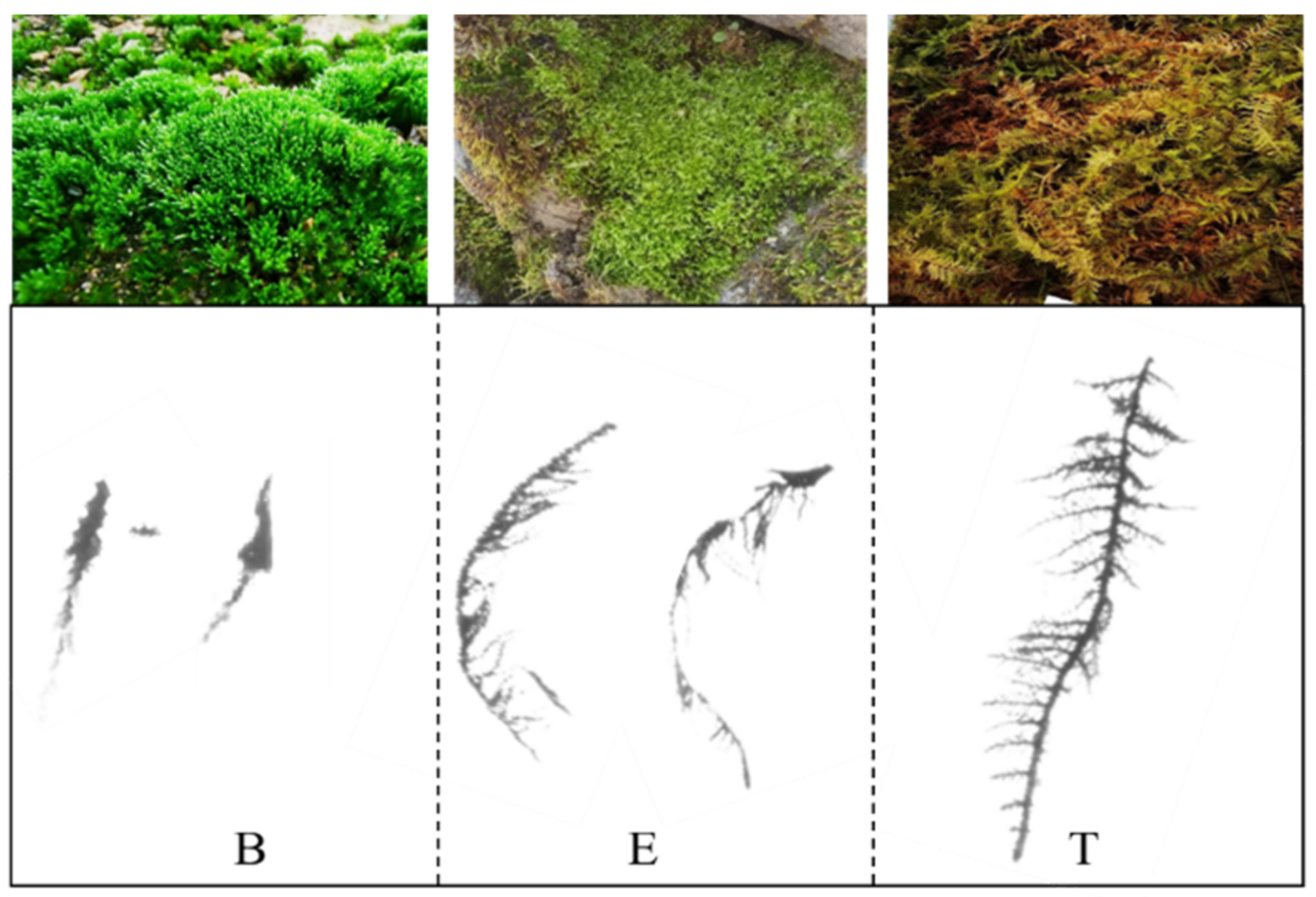
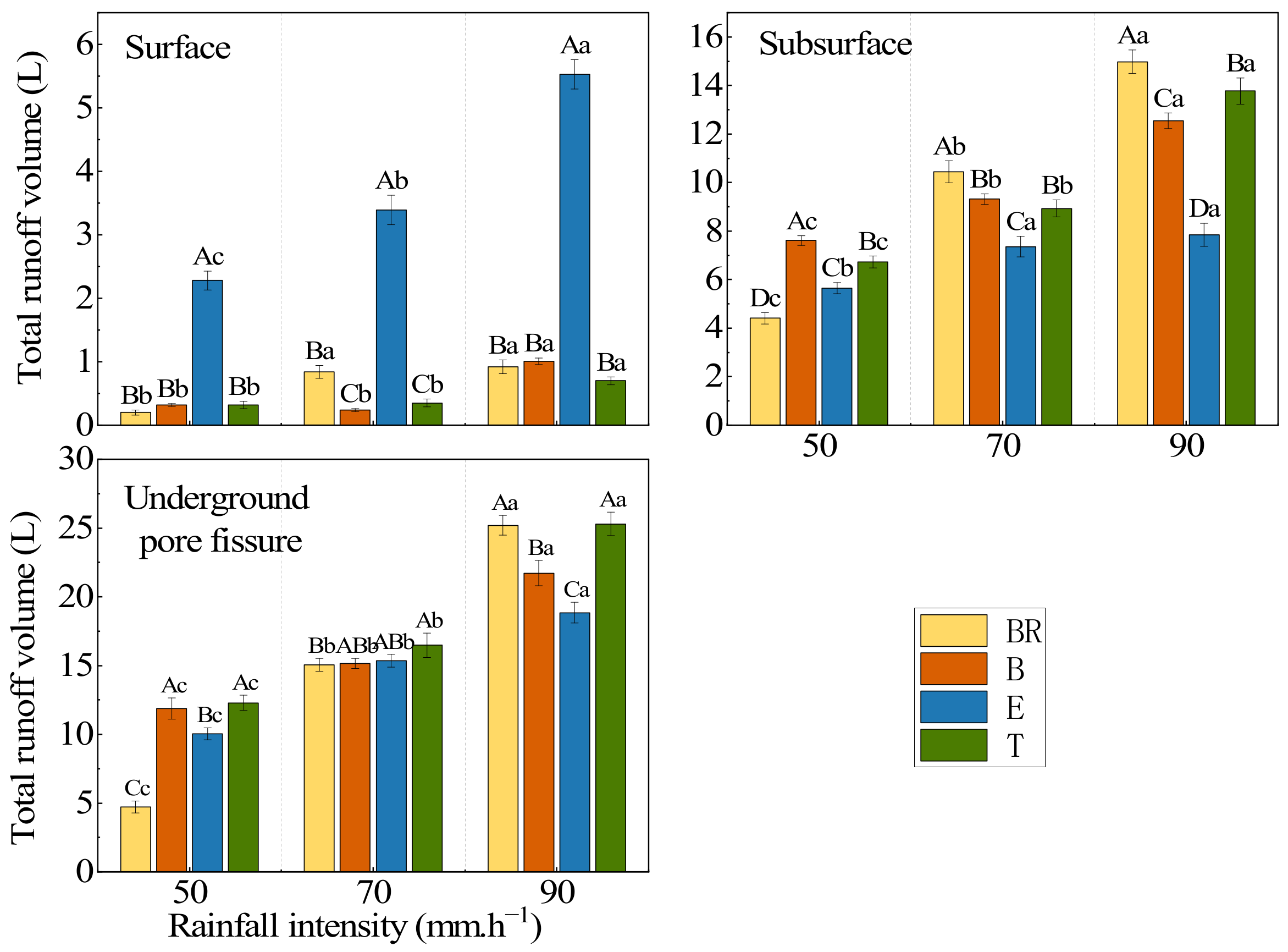
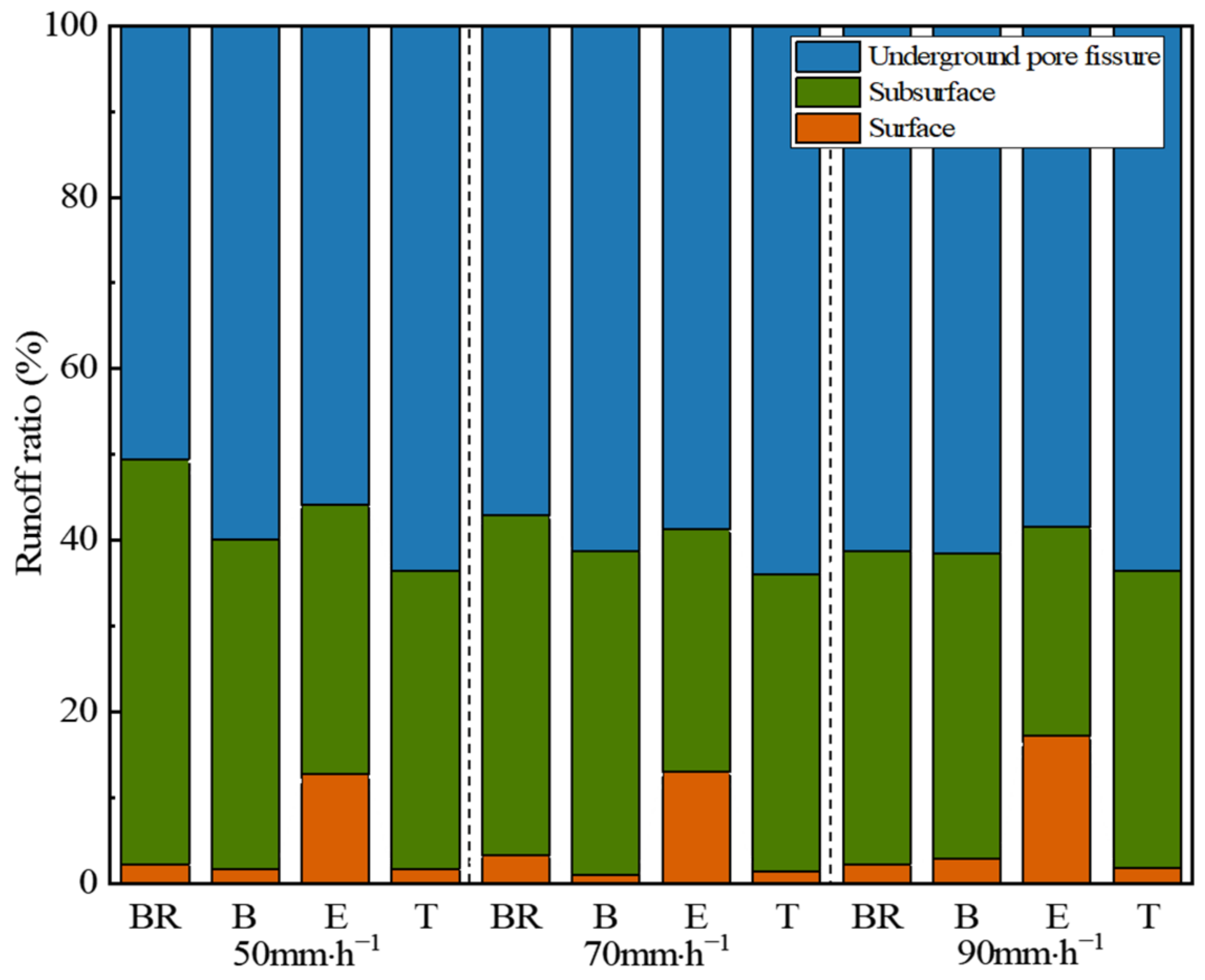


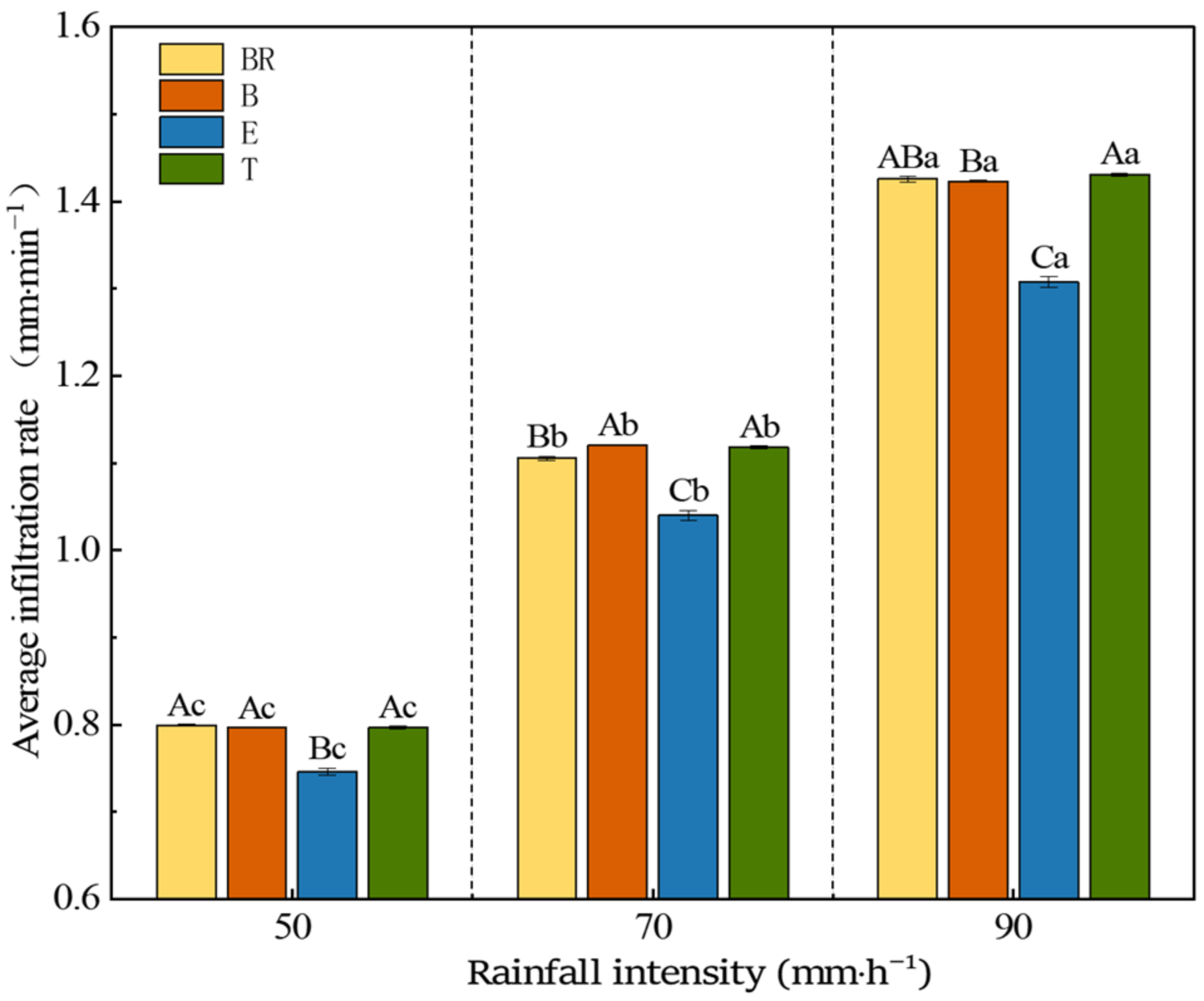

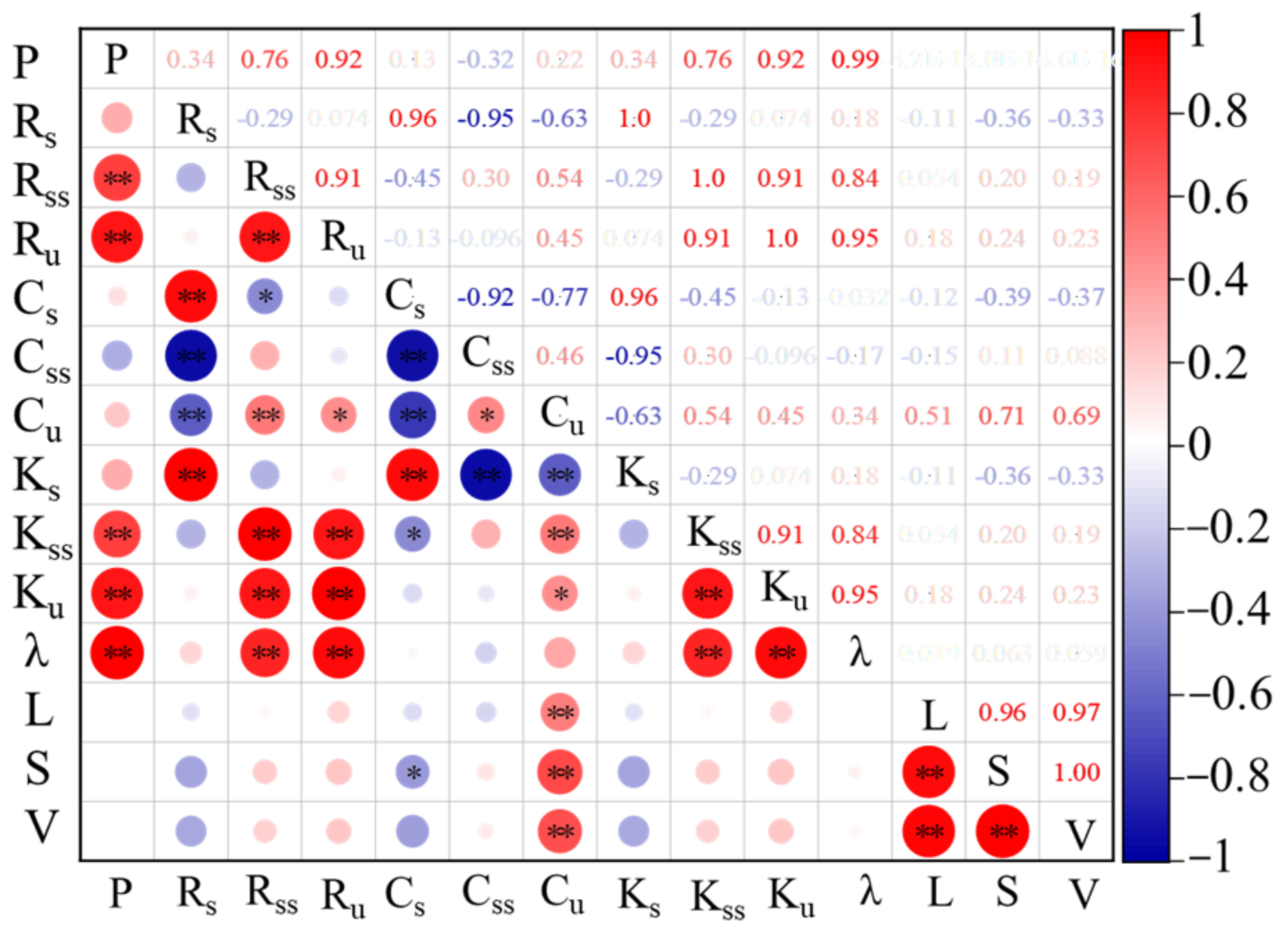
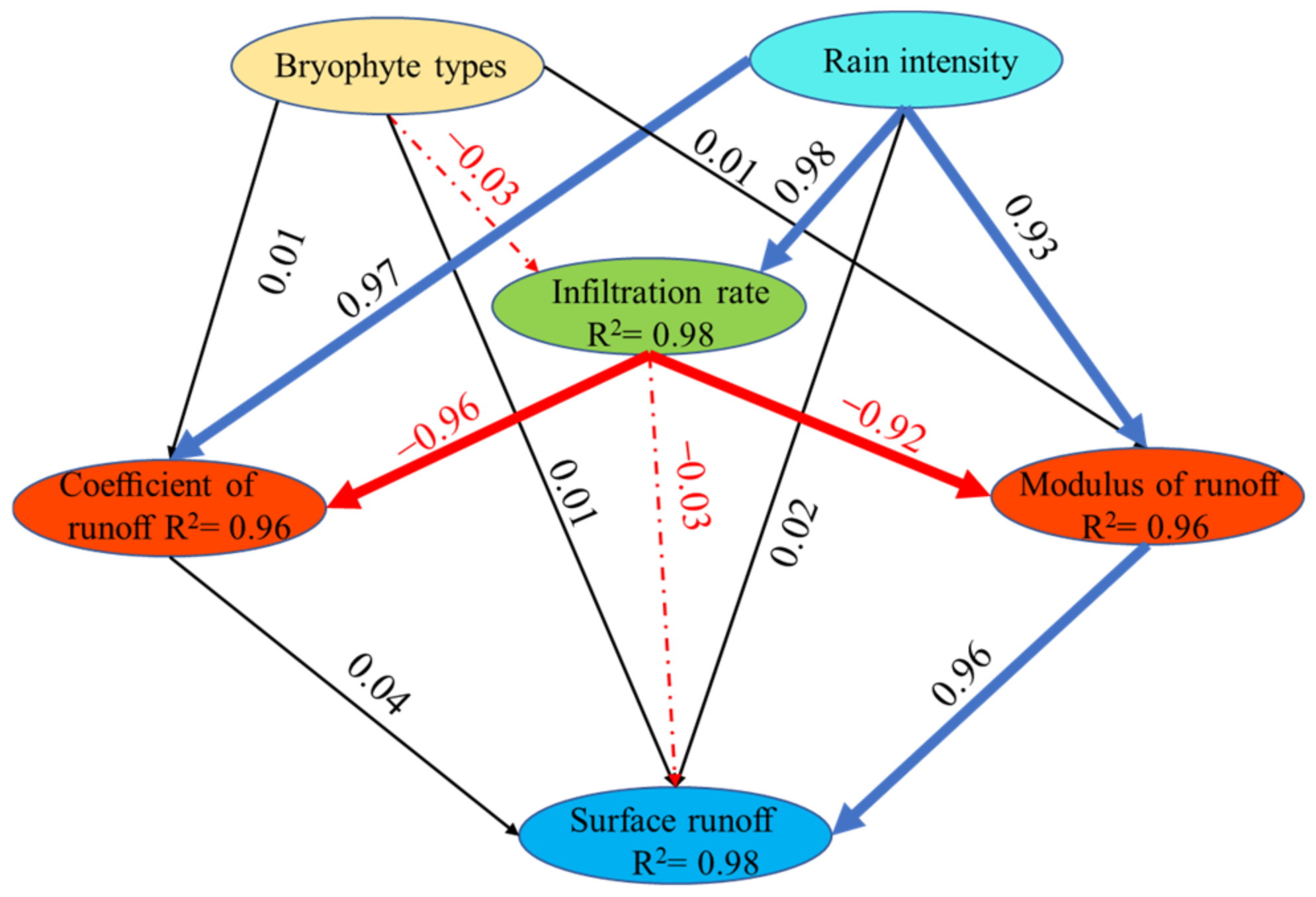
| Bryophyte | Life form | L (cm) | S (cm2) | V(cm3) |
|---|---|---|---|---|
| B | Cluster type | 1.004 ± 1.403 b | 0.614 ± 0.055 b | 0.003 ± 0.00 b |
| E | Cross type | 8.996 ± 2.527 b | 1.013 ± 0.163 b | 0.008 ± 0.001 b |
| T | Cross type | 17.531 ± 9.483 a | 3.518 ± 1.384 a | 0.033 ± 0.014 a |
| Type | Rainfall Intensity (mm·h−1) | Coefficient of Runoff | |||
|---|---|---|---|---|---|
| BR | B | E | T | ||
| Surface | 50 | 0.022 ± 0.003 Bb | 0.016 ± 0.001 Bb | 0.127 ± 0.004 Ab | 0.016 ± 0.002 Ba |
| 70 | 0.032 ± 0.002 Ba | 0.010 ± 0.001 Cc | 0.130 ± 0.003 Ab | 0.013 ± 0.002 Ca | |
| 90 | 0.022 ± 0.002 Cb | 0.029 ± 0.001 Ba | 0.172 ± 0.001 Aa | 0.018 ± 0.001 Da | |
| Subsurface | 50 | 0.473 ± 0.011 Aa | 0.385 ± 0.009 Ba | 0.314 ± 0.001 Da | 0.348 ± 0.004 Ca |
| 70 | 0.396 ± 0.003 Ab | 0.377 ± 0.006 Bb | 0.282 ± 0.004 Db | 0.347 ± 0.005 Ca | |
| 90 | 0.365 ± 0.001 Ac | 0.356 ± 0.011 ABb | 0.243 ± 0.004 Dc | 0.346 ± 0.002 Ca | |
| Underground pores | 50 | 0.505 ± 0.010 Dc | 0.599 ± 0.009 Ba | 0.559 ± 0.004 Cb | 0.636 ± 0.003 Aa |
| 70 | 0.572 ± 0.004 Db | 0.613 ± 0.007 Ba | 0.588 ± 0.007 Ca | 0.640 ± 0.004 Aa | |
| 90 | 0.613 ± 0.002 Ba | 0.616 ± 0.012 Ba | 0.585 ± 0.003 Ca | 0.636 ± 0.002 Aa | |
| Type | Rainfall Intensity (mm·h−1) | Modulus of Runoff (L/(m2·h)) | |||
|---|---|---|---|---|---|
| BR | B | E | T | ||
| Surface | 50 | 0.31 ± 0.06 Bcd | 0.50 ± 0.04 Bb | 3.51 ± 0.23 Ac | 0.49 ± 0.09 Bb |
| 70 | 1.30 ± 0.15 Ba | 0.37 ± 0.03 Cb | 5.22 ± 0.36 Ab | 0.54 ± 0.09 Cb | |
| 90 | 1.41 ± 0.17 Ba | 1.56 ± 0.08 Bc | 8.50 ± 0.35 Aa | 1.08 ± 0.09 Ba | |
| Subsurface | 50 | 6.78 ± 0.37 Dc | 11.70 ± 0.31 Ac | 8.69 ± 0.35 Cb | 10.36 ± 0.38 Bc |
| 70 | 16.06 ± 0.70 Ab | 14.34 ± 0.34 Bb | 11.33 ± 0.64 Ca | 13.74 ± 0.54 Bb | |
| 90 | 23.04 ± 0.76 Aa | 19.30 ± 0.49 Ca | 12.07 ± 0.73 Da | 21.18 ± 0.83 Ba | |
| Underground pore fissure | 50 | 7.25 ± 0.68 Cc | 18.26 ± 1.18 Ac | 15.45 ± 0.67 Bc | 18.91 ± 0.85 Ac |
| 70 | 23.15 ± 0.74 Bb | 23.30 ± 0.57 ABb | 23.61 ± 0.73 ABb | 25.36 ± 1.35 Ab | |
| 90 | 38.76 ± 1.11 Aa | 33.41 ± 1.40 Ba | 28.98 ± 1.15 Ca | 38.92 ± 1.29 Aa | |
Publisher’s Note: MDPI stays neutral with regard to jurisdictional claims in published maps and institutional affiliations. |
© 2022 by the authors. Licensee MDPI, Basel, Switzerland. This article is an open access article distributed under the terms and conditions of the Creative Commons Attribution (CC BY) license (https://creativecommons.org/licenses/by/4.0/).
Share and Cite
Tu, N.; Dai, Q.; Yan, Y.; Peng, X.; Meng, W.; Cen, L. Effects of Moss Overlay on Soil Patch Infiltration and Runoff in Karst Rocky Desertification Slope Land. Water 2022, 14, 3429. https://doi.org/10.3390/w14213429
Tu N, Dai Q, Yan Y, Peng X, Meng W, Cen L. Effects of Moss Overlay on Soil Patch Infiltration and Runoff in Karst Rocky Desertification Slope Land. Water. 2022; 14(21):3429. https://doi.org/10.3390/w14213429
Chicago/Turabian StyleTu, Na, Quanhou Dai, Youjin Yan, Xudong Peng, Wenping Meng, and Longpei Cen. 2022. "Effects of Moss Overlay on Soil Patch Infiltration and Runoff in Karst Rocky Desertification Slope Land" Water 14, no. 21: 3429. https://doi.org/10.3390/w14213429
APA StyleTu, N., Dai, Q., Yan, Y., Peng, X., Meng, W., & Cen, L. (2022). Effects of Moss Overlay on Soil Patch Infiltration and Runoff in Karst Rocky Desertification Slope Land. Water, 14(21), 3429. https://doi.org/10.3390/w14213429








